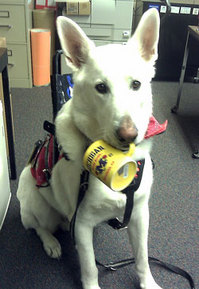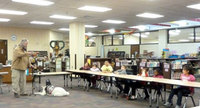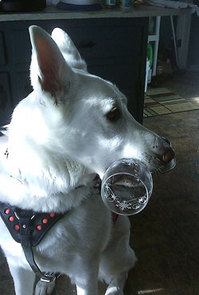What can a service dog do? Pick up broken glass, among many other things

Storm demonstrating his training by holding a coffee mug for me.
Ronald Wiedbusch | Contributor
I use myself and my Service Dog, Storm, as the example of how a Service Dog can be trained to perform tasks directly related to the specific disabilities of their owner/handler. I had Storm demonstrate with me how he stands erect in front of me when I fall to the ground due to nerve damage caused by a spinal injury. Storm can also, on command, hold perfectly still, locking his body (in a highly advanced K-9 skill is called ‘bracing”) so I can pull my 300-pound physical frame off the ground and into an upright position. This team work between myself and my Service Dog Storm is the proper use and example of what the federal definition of a service dog was supposed to stand for since its creation.
I shared with these students that, for the last 20 years, the ADA stood as one of nation's most important civil rights laws and that in July 2010, some important changes where made to it that will start February 2011. One of the biggest changes, in my view, is dealing with service animals.
I informed the students that the new ADA law removes the phrase "or other animal" and adds a requirement that the only recognized ADA Service Animal is now a dog. From February 2011 forward, the term service animal means any dog that is individually trained to do work or perform tasks for the benefit of an individual with a disability, including physical, sensory, psychiatric, intellectual or other mental disability.
There are many examples of how many people flouted the previous, less strict ADA law by falsely claiming their pets as service animals, making it hard for a truly disabled person with a properly trained animal to be respected. These law breakers believed that because their pet dog provided comfort to them, they had the right to take their pet dogs anywhere they went.
These assumptions are a gross misuse of the intent of the ADA's law concerning service animals. The 2010 ADA revisions clearly define that the dog must have training to perform tasks that are directly related to the specific disability of the owner. Just because a disabled person has a dog does not mean the dog is necessarily a qualified Service Animal.
An example of this would be a blind person’s untrained pet dog that barks when the phone rings. These dogs no longer qualify as Service Animals because the blind person still can hear this phone ring, and the performed task provides no additional benefit to the blind person.
This is also a good time to explain the difference between a Service Dog and an a Therapy Dog to the students.

Storm and I teaching students about the ADA.
Ronald Wiedbusch | Contributor
I explain that a Therapy Dog is very different from a Service Dog and is not part of the ADA.
A Therapy Dog must be a minimum of one year old and have a sound temperament. Each dog must first pass a temperament evaluation for suitability to become a Therapy Dog, which includes the American Kennel Club Canine Good Citizen Test (CGC). Additional testing will include evaluation of the dog's behavior around all ages of people, along with an evaluation of their ability to be around those with service equipment (crutches, wheelchairs, walkers, etc.)
These K-9s must be in good physical health (cannot be deaf) and have a physical evaluation by a licensed vet. Additional training and testing is done to ensure the dogs sits politely, accepts strangers, walks correctly on a leash both alone and in a crowded room, sits downs on command, stays in place when directed, leaves falling objects and food alone, comes when called, does not react in a negative way to other dogs, does not react to loud distractions and will not act out during supervised separation from their handler.
Therapy Dogs may go to facilities where invited, such as a hospital and nursing homes, help with reading at schools and county libraries, bring comfort and support during disasters and visit with our veterans at extended stay facilities. I finish up by saying a Therapy Dog is an angel with four paws, a wet nose, bright eyes and a tail — and the kids all laugh.
Another student shares with the group that he has seen my Assistance Dog Storm pick up my dropped work keys and wants to hear about these amazing retrieval skills. Storm is a very intelligent canine who has a number of problem solving skills that allow him to think out an issue and then apply the proper skill to resolve the problem.
I explain that because of my spinal injury from the car accident along with mobility and balancing issues, I also have nerve tremors that, at times, cause me to drop objects out of my hands. Storm had to go away for advanced object retrieval training that was done by Lori Griggs of Paradise Dog Training. She had a monumental task to not only teach Storm all the basic retrieval skills and commands, but then to take it up a notch to develop his problem solving skills so he would be prepared for the unexpected when it happened. Basic retrieval training covers the size and weights of objects, object textures and consistency, the warmth and coolness, taste and structure and poisons. But Storm's training was not stopped there as he was exposed to every situation they could imagine and had to perform at a level of solving them 100 percent of the time.
Here is a example:
The simple dropping of my cell phone.
In a perfect world, the cell phone would hit the floor, and Storm would have the one simple task of retrieving it for me with no mouth pressure as to not cause damage to the glass screen.
But ours is a world of surprises. In this situation when the cell phone hits the floor, the phone’s rear casing comes off and flyies in one direction and then the cell battery pops out in another direction. Now we have a three-step retrieval process, and with no additional commands, Storm has to process and do all three steps — 100 percent accuracy to ensure that my cell phone is back in working order.

Storm Holding a wine glass to showing how careful he can be.
Ronald Wiedbusch | Contributor
Another example would be the dropping of a glass while washing dishes:
In this perfect world the glass would hit the floor and stay in one piece. Storm would then have the one simple task of retrieving the glass in tack to me by the glass stem handle.
Once again though, nothing is perfect. Invariably, when the glass hits the floor, it breaks into pieces Storm has to problem solve once the command is given. He has to pick up the broken pieces, then he has to hand me those pieces to place them out of harms way. These problem solving abilities that Storm has places him in a class by himself.
These are just brief examples of what Service Dogs can do to assist persons with disabilities. Whether we have been invited to visit schools or in other public forums — or if we are simply out and about during our day — Storm and I truly enjoy any opportunity to talk to the public about the ADA and the unique partnership we have.
Ron Wiedbusch is a regular contributor to AnnArbor.com's pets section and works in the community to raise awareness about Assistance and Therapy Dogs and the Americans with Disabilities Act with his certified Assistance, Service, Rescue and Therapy Dog, Storm. The pair can be found at various places in the community throughout the week, and each day patrolling the area around Ypsilanti Public Schools as part of the Safe Schools Program.

